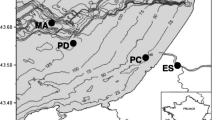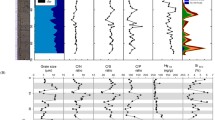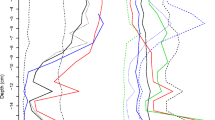Abstract
To clarify the ecological significance of the association of sulfate-reducing bacteria (SRB) with sediment particle size, SRB utilizing lactate (l-SRB), propionate (p-SRB) and acetate (a-SRB) were examined with different sizes of sediment particles in a hypertrophic freshwater lake using the anaerobic plate count method. The numbers ofl-SRB anda-SRB were 104–105 colony forming units (CFU) per ml in the 0–3 cm layer and 102–103 CFU ml−1 in the 10–13 cm layer while the numbers ofp-SRB were one or two orders lower than those ofl-SRB anda-SRB. A sediment suspension was fractionated into four fractions (<1, 1–10, 10–94 and >94 μm). The highest proportions ofl-SRB anda-SRB were found in the 10–94 μm fraction: 66–97% forl-SRB and 53–98% fora-SRB. The highest proportion ofp-SRB was found in the >94 μm fraction (70–74%). These results indicate that most SRB were associated with sediment particles. One isolate from an acetate-utilizing enrichment culture was similar toDesulfotomaculum acetoxidans, a spore-forming sulfate-reducing bacterium. When lactate and sulfate were added to sediment samples,l-SRB anda-SRB in the <10 μm-fraction grew more rapidly than those in whole sediment for the first 2 days. This result suggests that nutrients uptake by free-living and small particle-associated (<10 μm) SRB is higher than that by SRB associated with larger particles.
Similar content being viewed by others
References
Amann R. I., Binder B. B., Olson R. J., Chisholm S. W., Devereux R. &Stahl D. A. (1990) Combination of 16S rRNA-targeted oligonucleotide probes with flow cytometry for analyzing mixed microbial populations.Applied and Environmental Microbiology 56: 1919–1925.
Amann R. I., Ludwig W. &Schleifer K. (1995) Phylogenetic identification andin situ detection of individual microbial cells without cultivation.Microbiological Reviews 59: 143–169.
Brock T. D., Madigan M. T., Martinko J. M. &Parker J. (1994)Biology of Microorganisms, 6th edn. Prentice-Hall, New Jersey.
Butlin K. R., Adams M. E. &Thomas M. (1949) The isolation and cultivation of sulfate-reducing bacteria.Journal of General Microbiology 3: 46–59.
Christensen D. &Blackburn T. H. (1982) Turnover of14C-labeled acetate in marine sediments.Marine Biology 71: 113–119.
Cypionka H., Widdel F. &Pfennig N. (1985) Survival of sulfate-reducing bacteria after oxygen stress, and growth in sulfate-free oxygen-sulfide gradients.FEMS Microbiology and Ecology 31: 39–45.
Devereux R., Kane M. D., Winfrey J. &Stahl D. A. (1992) Genus- and group-specific hybridization probes for determinative and environmental studies of sulfate-reducing bacteria.Systematic and Applied Microbiology 15: 601–609.
Elsgaard L. &Jørgensen B. B. (1992) Anoxic transformations of radiolabeled hydrogen sulfide in marine and freshwater sediments.Geochimica Cosmochimica Acta 56: 2425–2435.
Fukui M. &Fukuhara H. (1987) Colony formation on agar plates by sulfate-reducing bacteria in water and sediment of lake.Bulletin of Japanese Society of Microbial Ecology 1: 75–78.
Fukui M., Suwa Y. &Urushigawa Y. (1996) High survival efficiency and the ribosomal RNA decaying pattern ofDesulfobacter latus, a high specific acetate-utilizing organism, during starvation.FEMS Microbiology and Ecology 19: 17–25.
Fukui M. &Takii S. (1987) Distribution of lactate-, propionate-, and acetate-oxidizing sulfate-reducing bacteria in various aquatic sediments.Japanese Journal of Limnology 48: 249–256.
Fukui M. &Takii S. (1989a) Reduction of tetrazolium salts by sulfate-reducing bacteria.FEMS Microbiology and Ecology 62: 13–20.
Fukui M. &Takii S. (1989b) Kinetics of colony formation by sulfate-reducing bacteria.Bulletin of Japanese Society of Microbial Ecology 3: 67–71.
Fukui M. &Takii S. (1990a) Colony formation of free-living and particle-associated sulfate-reducing bacteria.FEMS Microbiology and Ecology 73: 85–90.
Fukui M. &Takii S. (1990b) Survival of sulfate-reducing bacteria in oxic surface sediment of a seawater lake.FEMS Microbiology and Ecology 73: 317–322.
Fukui M. &Takii S. (1990c) Seasonal variations of population density and activity of sulfate-reducing bacteria in offshore and reed sediments of a hypertrophic freshwater lake.Japanese Journal of Limnology 53: 63–71.
Fukui M. &Takii S. (1994) Kinetics of sulfate respiration by free-living and particle-associated sulfate-reducing bacteria.FEMS Microbiology and Ecology 13: 241–248.
Furusaka C. (1968) Studies on the activity of a sulfate reducer in paddy soil.The Reports of the Institute of Agricultural Research, Tohoku University 19: 101–184.
Furusaka C., Nagatsuka Y. & Ishikuri S. (1991) Survival of sulphate-reducing bacteria in oxic layer of paddy soil.Proceedings of the 8th International Symposium for Environmental Biogeochemistry, pp. 259–266.
Hattori T. &Furusaka C. (1958) Studies on the sulfate reducing activity of several paddy soils.Bulletin of Institute of Agricultural Research. Tohoku University 10: 55–62.
Hahn D., Amann R. I., Ludwig W., Akkermans A. D. L. &Schleifer K-H. (1992) Detection of micro-organisms in soil afterin situ hybridization with rRNA-targeted, fluorescently labelled oligonucleotides.Journal of General Microbiology 138: 879–887.
Howarth R. W. &Merkel S. (1984) Pyrite formation and the measurement of sulfate reduction in salt marsh sediment.Limnology and Oceanography 29: 598–608.
Jørgensen B. B. (1977) Bacterial sulfate reduction within reduced microniches of oxidized marine sediments.Marine Biology 41: 7–18.
Kobayashi S. (1982) Transition of ecosystem in Lake Teganuma caused by water pollution.Water and Waste 24: 3–14 (in Japanese).
Konda T. (1984) Seasonal variations in four bacterial size fractions from a hypertrophic pond in Tokyo, Japan.Internationale Revue der Gesamten Hydrobiologie 69: 843–858.
Laanbroek H. &Peennig N. (1981) Oxidation of short chain fatty acids by sulfate-reducing bacteria in freshwater and in marine sediments.Archives of Microbiology 128: 330–335.
Lawongsa P., Inubushi K. &Wada H. (1987) Determination of organic acids in soil by high performance liquid chromatography.Soil Science and Plant Nutrition 33: 299–302.
Maeda H., &Kawai A. (1987) Determination of organic acids in the lake sediment.Nippon Suisan Gakkaishi 52: 1205–1208.
Marnette E. C., Hordijk C., Breemen N. V. &Cappenberg T. (1992) Sulfate reduction and S-oxidation in a moorland pool sediment.Biogeochemistry 17: 123–143.
Munson D. A. (1977) Simplified method for the determination of acid-soluble sulfides in marine sediments.Marine Biology 40: 145–150.
Nedwell D. B. (1984) The input and mineralization of organic carbon in anaerobic aquatic sediments.Advances in Microbial Ecology 7: 93–131.
Nedwell D. B. &Takii S. (1988) Bacterial sulphate reduction in sediment of European salt marsh: Acid-volatile and tin-reducible products.Estuarine, Coastal and Shelf Science 26: 599–606.
Parkes R.J., Gibson G.R., Mueller-Harvey I., Buckingham W. J. &Herbert R. J. (1989) Determination of the substrates for sulphate-reducing bacteria within marine and estuarine sediments with different rates of sulphate reduction.Journal of General Microbiology 135: 175–187.
Pfennig N., Widdel F. &Trüper H. G. (1981) The dissimilatory sulfate-reducing bacteria. In:The Prokaryotes (eds M. P. Starr, H. Stolp, H. G. Trüper & H. G. Schlegel) pp. 926–940, Springer-Verlag, New York.
Ramsing N., Kühl M. &Jørgensen B. B. (1993) Distribution of sulfate-reducing bacteria, O2, H2S in photosynthetic biofilms determined by oligonucleotide probes and microelectrodes.Applied and Environmental Microbiology 59: 3840–3849.
Rubentschik L., Roisin M. B. &Bieljansky F. M. (1936) Adsorption of bacteria in salt lakes.Journal of Bacteriology 32: 11–31.
Sakurai Y. (1967) Some examination on the method for enumerating viable heterotrophic bacteria in water.Journal of Japan Biological Society for Water Waste 2: 21–27 (in Japanese).
Sweerts J-P. B. R. A., Rudd J. W. M. &Kelly C. A. (1986) Metabolic activities in flocculant surface sediments and underlying sandy littoral sediments.Limnology and Oceanography 31: 330–338.
Takeda K. &Fukui M. (1995) Conversion of lactate to methane by triculture of sulfate-reducer and methanogens.Bulletin of Japanese Society of Microbial Ecology 10: 1–7.
Thamdrup B., Finster K., Hansen J. W. &Bak F. (1993) Bacterial disproportion of S0 coupled to chemical reduction of iron or manganese.Applied and Environmental Microbiology 59: 101–108.
Thompson L. A. &Nedwell D. B. (1985) Existence of different pools of fatty acids in anaerobic model ecosystems and their availability to microbial metabolism.FEMS Microbiology and Ecology 31: 141–146.
Wakao N. &Furusaka C. (1972) A new agar method for the quantitative study of sulfate-reducing bacteria in soil.Soil Science and Plant Nutrition 18: 39–44.
Wakao N. &Furusaka C. (1976) Presence of micro-aggregates containing sulfate-reducing bacteria in a paddy-field soil.Soil Biology and Biochemistry 8: 157–159.
Widdel F. (1988) Microbiology and ecology of sulfate-and sulfur-reducing bacteria. In:Biology of Anaerobic Microorganisms (ed. A. J. B. Zehnder) pp. 469–585. John Wiley & Sons, New York.
Widdel F. (1992) The GenusDesulfotomaculum. In:The Prokaryotes: A Handbook on The Biology of Bacteria: Ecophysiology, Isolation, Identification, Applications, 2nd edn (eds A. Balows, H. G. Trüper, M. Dworkin, W. Harder & K. D. Shleifer) pp. 1792–1799. Springer-Verlag, New York.
Widdel F. &Bak F. (1992) Gram-negative mesotrophic sulfate-reducing bacteria. In:The Prokaryotes: A Handbook on The Biology of Bacteria: Ecophysiology, Isolation, Identification, Applications, 2nd edn (eds A. Balows, H. G. Trüper, M. Dworkin, W. Harder & K. D. Shleifer) pp. 3353–3378. Springer-Verlag, New York.
Author information
Authors and Affiliations
About this article
Cite this article
Fukui, M., Takii, S. Microdistribution of sulfate-reducing bacteria in sediments of a hypertrophic lake and their response to the addition of organic matter. Ecol. Res. 11, 257–267 (1996). https://doi.org/10.1007/BF02347783
Received:
Accepted:
Issue Date:
DOI: https://doi.org/10.1007/BF02347783




